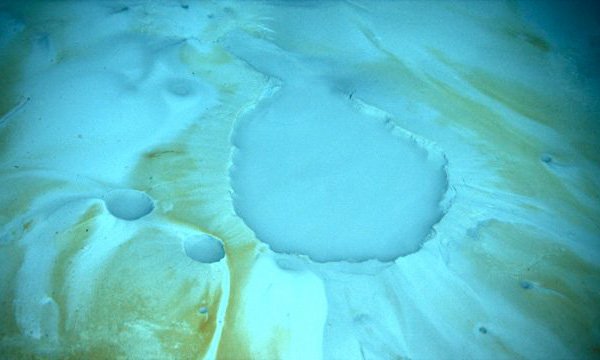Welcome nature-loving Steemians! Today I was thinking of taking you to a relaxing underwater spa trip. Think about it, beautiful corals showing us the way, pufferfish applying beauty treatments on our face, starfish and crabs giving us massages and hundreds of mussels keeping us company in the jacuzzi. Yes, this idea sounds incredibly luring, but it would damage this post series' reputation if there was no danger involved.
So, yes, we are going underwater. Yes, we are visiting a submerged hot tub. But no, it is not the relaxing and perfectly safe place to be. Ladies and genlemen, meet "The Jacuzzi Of Despair"!
(Image source: latimes.com/science)
Who found it?
While scientists have been aware of underwater lakes' existence for almost 30 years, this specific pool was unknown until a remote-controlled, underwater robot (Hercules) accidentally discovered it in 2014, 3,330 feet (almost 1000 meters) deep under the Gulf of Mexico. One year later, an associate professor of biology at Temple University (Philadelphia), Erik Cordes, came back with a three-person team in a sub (Alvin) and examined the spot. Their findings were published in the scientific journal Oceanography in March 2016.
What does it look like?
Surrounded by a 10-foot (3-meter) tall rim, which is covered by hundreds of mussels, the pool has a 100-foot (30-meter) circumference and its bottom lies deeper than 62 feet (approximately 19 meters). Inside it you will find warm water (about 65°F - 18.3 °C), at least warmer than the surrounding (about 40 °F - 4.4 °C), and it's 4-5 times saltier than regular sea water. This means that it's more viscous and cannot mix with sea water, so you can view the out-flowing salty streams like an underwater waterfall (a waterfall within a huge mass of water, I mean, how cool is that?).
This awkwardly dense water, though, is not so safe to swim in. High salinity levels, along with methane gas (CH4) and hydrogen sulfide (H2S) presence turn the lake into a caustic pool that serves death to unsuspicious swimmers. The poor animals that are driven towards the lake by its higher temperatures never make it out of there alive and their carcasses have been "decorating" the lake's interior for years.
(Image source: latimes.com/science)
How did it form?
So, who made this killer hot tub? Was it Triton who wanted to keep his kingdom safe from intruders? Was it a mermaid seeking to revenge an unfaithful husband? Although it could be the case, the answer is no. There is a scientifically-based theory that sounds more plausible.
This pool's creation dates back between 200 and 145.5 million years ago, during the Jurassic period (Yes, you got it right, back when dinosaurs ruled the Earth and our planet had little to do with what we see today). Back then, the Gulf of Mexico was a shallow sea, that was cut off from the ocean due to the tectonic plates continual movement. As a result, the sea evaporated leaving behind huge portions of salt.
Some time later the area was covered in water again and re-united with the ocean. Before that, insoluble sediment had already covered those huge sheets of salt (salt layers a few kilometers thick) and as the weight of the ocean began to crush these layers and push them further deep in the underground, some of the salt started to emerge on the seafloor (this process is known as "salt tectonics").
The salt deriving from the deeper underground met the seawater, dissolved in it and formed masses of brine that sat over the seafloor. That's how our little hot tub from hell was formed and there must be more like this one, hiding beneath the halocline (the layer separating regular seawater from dense brine masses) and waiting to be discovered.

(Image source: wikipedia.org)
What about life?
As unlikely as it may sound, there can be life within these deadly waters, but no lovely seahorses and crabs. Some shrimps and tube worms have been detected living near these toxic waters. The rim of the lake is also occupied by giant mussels that have symbiotic bacteria in their gills. The bacteria have been supporting life in this weird ecosystem by feeding off the lake's methane gas and hydrogen sulfide. The research team have also collected samples of extremophile bacteria that live inside the lake and don't seem to be bothered by these highly saline, low-in-oxygen, toxic waters.
Some believe that studying those extreme-conditions survivors can get us a good model of how life could be sustained on other planets. But all these would be plain hypotheses, as no one can say for sure whether these models of life would definitely apply on any other planet, no matter how complete and accurate models we form through terrestrial life observation. One thing is certain, though, that nature never ceases to surprise us and life never stops fighting!
Here is a short tour on this amazing "deadpool"
References
iflscience.com
csmonitor.com
atlasobscura.com
latimes.com
natureworldnews.com
treehugger.com

Thank you for reading today's post! I hope it got you intrigued enough to follow me, @ruth-girl, for more fascinating phenomena!
If nature's weirdness is your thing, you can check the previous articles of this series:
1 - Volcanic Lightning
2 - Bioluminescence
3 - Flammable Methane Ice
4 - Door To Hell
5 - Blue Lava
6 - Everlasting Lightning Storm
7 - The Mummifying Lake
8 - Ice Fumaroles
9 - Blood Falls
10 - The Lava Lake
11 - The Toxic Underwater Lake
12 - Underwater Crop Circles
Interested in science? Please, don't forget to check the @steemstem project, a community-driven project meant to promote well-written, high-quality, STEM-related content (STEM as for Science, Technology, Engineering and Mathematics). Join them in steemit.chat for more information.
And for those engaging with education, @steemiteducation is here to join all steemian educators in their common cause of making our job easier, more effective and more fun!
Until my next post,
Steem on, people, and keep smiling!


